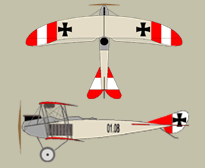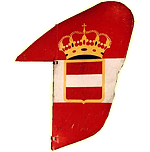Austro-Hungarian Air Service
| Imperial and Royal Aviation Troops | |
|---|---|

An Oeffag built Albatros D.III flown by Godwin Brumowski (the man on the left)
|
|
| Active | 1893–1918 |
| Country |
|
| Size | 5431 aircraft produced for the KuKLFT |
| Engagements | World War I |
| Commanders | |
| Notable commanders |
Emil Uzelac Conrad von Hötzendorf |
| Insignia | |
| National Markings |  |
| Tail Markings |  |
| Aircraft flown | |
| Bomber | Hansa-Brandenburg G.I |
| Fighter |
Aviatik D.I Phönix D.I |
| Reconnaissance | Hansa-Brandenburg C.I |
The Imperial and Royal Aviation Troops (Kaiserliche und Königliche Luftfahrtruppen or K.u.K. Luftfahrtruppen) was the air force of the Austrian-Hungarian Empire until the empire's demise in 1918. It saw combat on both the Eastern Front and Italian Front during World War I.
The Air Service began in 1893 as a balloon corps (Militär-Aeronautische Anstalt) and would later be re-organized in 1912 under the command of Major Emil Uzelac, an army engineering officer. The Air Service would remain under his command until the end of World War I in 1918. The first officers of the air force were private pilots with no prior military aviation training.
At the outbreak of war, the Air Service was composed of 10 observation balloons, 85 pilots, and 39 operable aircraft. By the end of 1914, they managed to have 147 operational aircraft deployed in 14 units. Just as Austria-Hungary fielded a joint army and navy, they also had army and naval aviation arms. The latter operated seaplanes;Gottfried Freiherr von Banfield became an ace in one. The Adriatic Coast seaplane stations also hosted bombers. Lohners were the most common variant; however, the K Series heavy bombers mounted a successful offensive against the Italians that suffered few casualties.
Austro-Hungarian pilots and aircrew originally faced off against the air forces of Romania and Russia, while also fielding air units in Serbia, Albania, and Montenegro. Only the Imperial Russian Air Service posed a credible threat, although its wartime production of 4,700 air frames gave it no logistical edge over the Luftfahrtruppen before the IRAS ceased operations in mid-1917. Nevertheless, the Austro-Hungarians requested, and received, aerial reinforcements from their German allies, especially in Galicia.
...
Wikipedia
